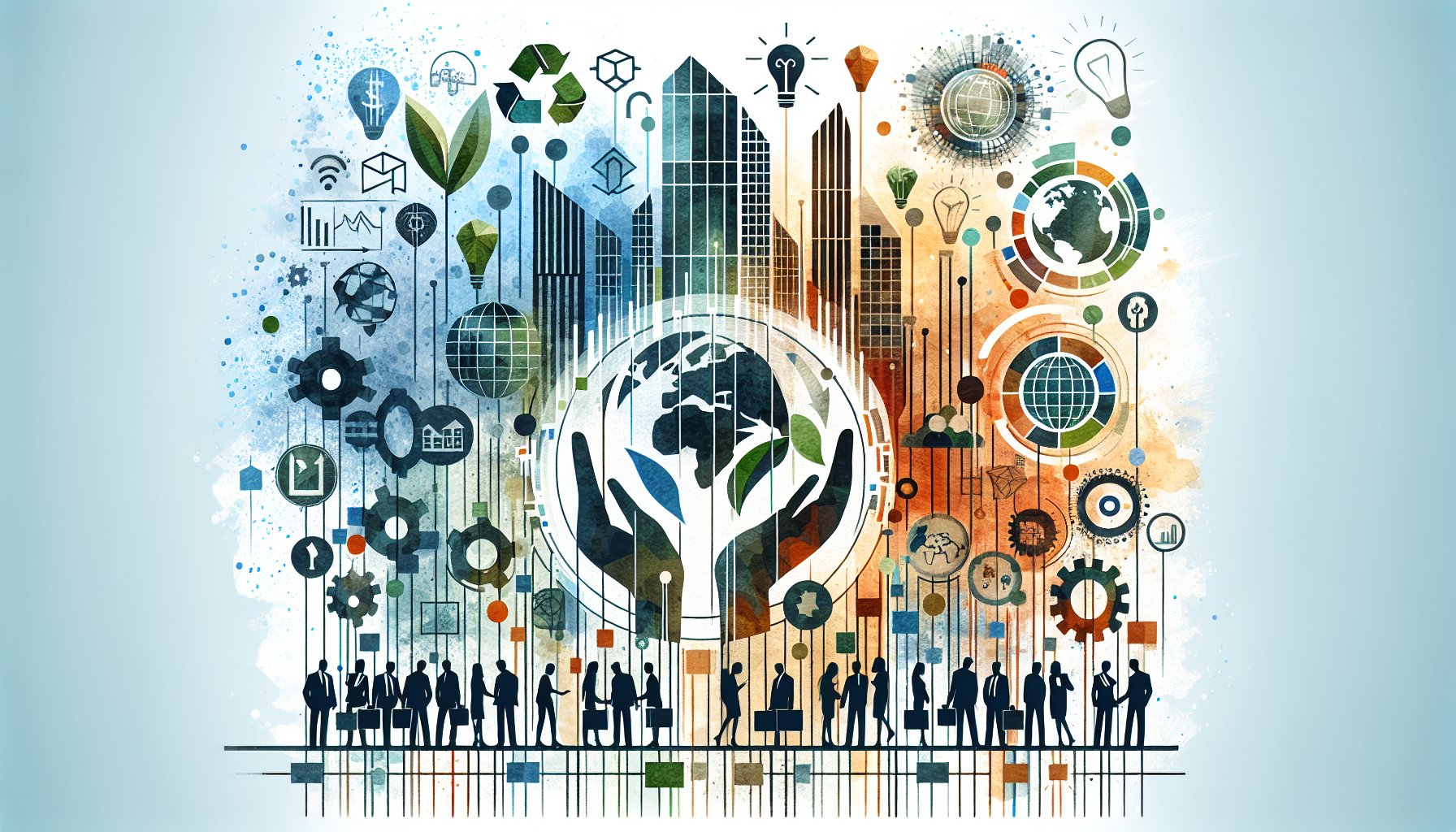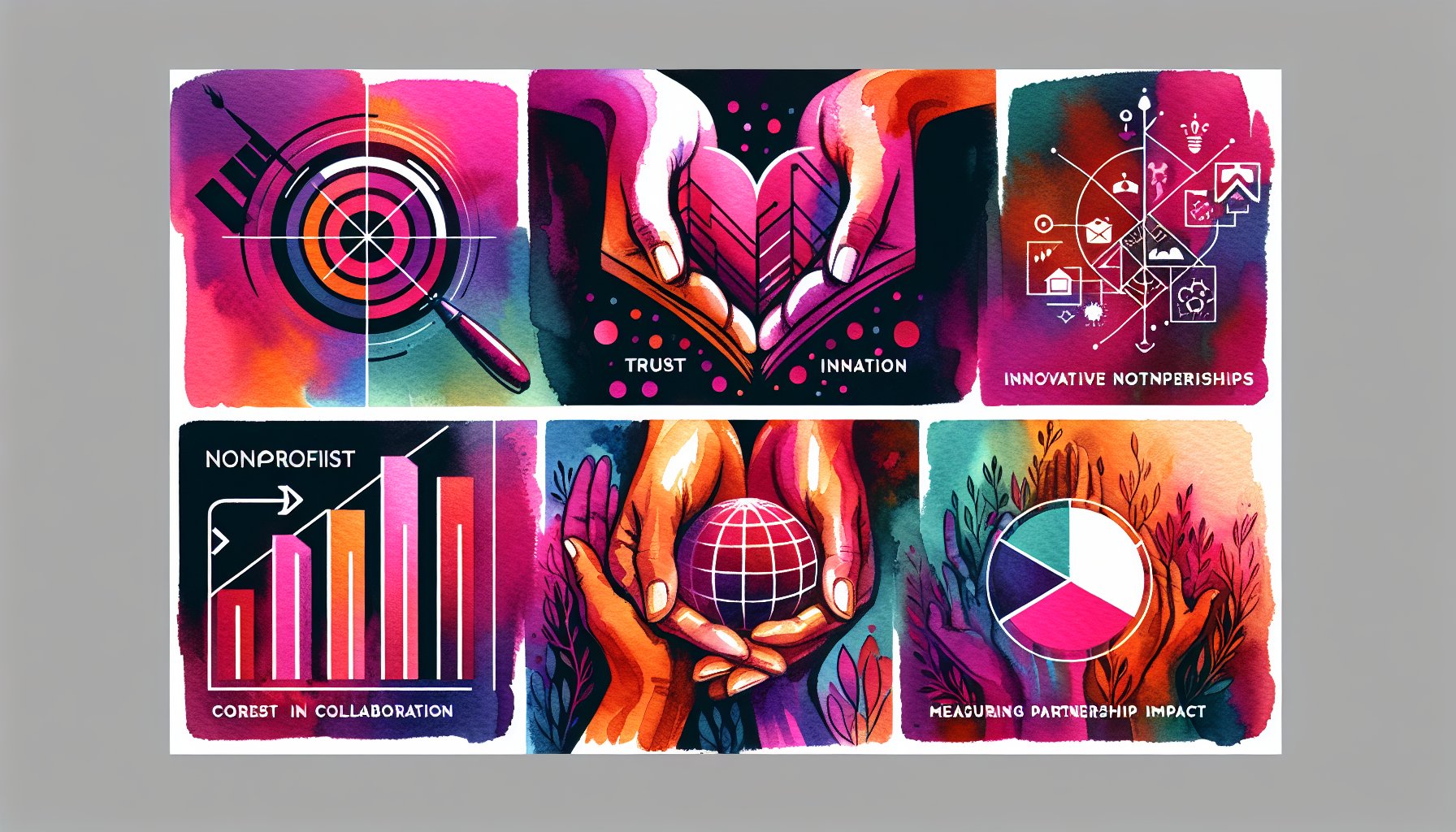Strengthening Partnerships
Building Stronger Business Partnerships: Key Insights for 2025
Discover essential strategies for building stronger business partnerships in 2025. Explore the importance of trust, technology, and inclusivity in navigating regulatory challenges and fostering collaboration for sustainable success.
Oct 18, 2025
12 min read

Building Stronger Business Partnerships: Key Insights for 2025
Weaving the Tapestry of Trust
Picture the modern business world as a swirling dance of complexity and unpredictability. At its core, the steadfast partner in this dance is the intricate tapestry of trust. Trust isn't just an ethereal idea or a nice-to-have; it's a tangible asset born out of shared values, transparent communication, and solid interactions. As highlighted in a recent Business Reporter webinar, hosted by the astute Anna Maria Velika, trust was painted not just as a glue but as a fortress for partnerships, especially against regulatory storms like the EU's Corporate Sustainability Due Diligence Directive (CS3D). This directive has become a game-changer, demanding businesses to be vigilant about ethical risks in their supply chains.
Enter the era where trust has shed its demure cloak of personal integrity or corporate reputation to become a structural necessity. It's the bedrock upon which compliance thrives, and businesses now juggle not just local laws like Germany’s Supply Chain Act, but also global standards. By fostering transparency and building bridges of understanding with suppliers and stakeholders, companies don't just aim for compliance, they create a vibrant ecosystem that's ripe for collaboration and innovation.
This commitment to trust and transparency goes beyond just ticking boxes; it's about nurturing a culture of continuous engagement and education. As industry stalwarts noted in the webinar, due diligence is evolving from a one-off checklist to an ongoing process. It demands regular audits, technological investments, and structured governance, yes, but it also requires a heart, a commitment to training and aligning all stakeholders towards shared objectives. When everyone is on the same ethical page, the symphony of partnership becomes harmonious.
Utah's recent workforce development study even echoed these themes, highlighting how strong communication and collaboration are the silent heroes of successful partnerships. It's not just about having a shared vision; it's about crafting it together. Businesses that embrace open feedback from all angles, employees, suppliers, and even those down the supply chain, will find themselves not just ready but eager to dance with change.
Ultimately, trust isn't just a component of business; it’s woven into every interaction, every decision. As companies brace for the complexities of 2025 and beyond, nurturing the fabric of trust won't just prepare them for compliance; it will forge resilient, forward-thinking partners ready to tackle whatever the evolving marketplace throws their way.
The Digital Renaissance: Leveraging Technology for Collaborative Success
As we teeter on the edge of 2025, it’s clear we’re amidst a digital renaissance. Think of it as not just a tech upgrade, but a seismic shift in how organizations envision collaboration, risk management, and operational resilience. Digital tools have become the swanky new cape draping over the shoulders of modern partnerships, enhancing transparency, and streamlining operations in ways that were once the stuff of sci-fi dreams.
This isn’t just about conquering supply chain beasts or nailing compliance down to a fine art; it’s about redefining reality. Thanks to the EU CS3D directive, companies are now proactive warriors against human rights and environmental risks, with technology as their armor and sword. This shift pushes ethical considerations up the priority list, right alongside good old profitability.
Consider the power of digital platforms in enhancing supplier engagement. With real-time analytics tools, companies can track supplier performance as effortlessly as checking the weather. This creates a dynamic understanding of supply chain health and risk profiles, allowing businesses to not just survive, but positively thrive with gusto. Technologies like AI and machine learning are the new crystal balls, predicting disruptions and informing crisis response with a precision that’s nothing short of wizardry.
This digital embrace isn’t just about staying ahead; it’s about leading the charge toward ethical, transparent, and sustainable business. For companies like Proforma Color Press, it's an open invitation to not only bolster operational resilience but to craft supply chains that are works of art in their own right. This isn't just about compliance, folks; it’s about setting the stage for enduring collaborative success as we march into 2025.
The Diversity Dividend: Expanding Horizons Through Inclusive Partnerships
In today’s global village, partnerships have outgrown their transactional shells. Diversity isn’t just a checkbox or a moral cause célèbre; it's the secret ingredient for innovation and competitive advantage. Enter the "Diversity Dividend", a concept capturing the tangible benefits of inclusive partnerships. As we gear up for 2025's challenges, it's diversity that will help us dance gracefully through the myriad regulatory landscapes.
Take, for example, a traditional printing company partnering with a digital design startup led by a vibrant team of varied backgrounds. This isn't just a partnership; it's an innovation factory, producing marketing materials that scream to be noticed by broader, more diverse audiences. Inclusivity isn't just critical to supply chain management; it’s the superpower that helps companies adapt their strategies to comply with emerging regulations seamlessly.
Emphasizing inclusivity also resonates with the workforce dynamics we’re seeing today. By aligning with educational institutions and diverse companies, we can prep the next generation with the soft skills that are as crucial as technical prowess. This collaboration creates an adaptable, innovative workforce ready to tackle diverse sectors and drive progress.
The Diversity Dividend isn't a lofty concept but a practical strategy for businesses like Proforma Color Press to claim a competitive edge, and perhaps even a moral one. As 2025 looms, the future belongs to those who see inclusivity not as a requirement but as a golden ticket to innovation and growth.
Navigating the New Normal: Adaptability in Partnership Dynamics
If 2025 is the destination, adaptability is the train that’ll get us there. The business partnership landscape is evolving at breakneck speed, thanks in no small part to global disruptions that have forced us to challenge the status quo. Adaptability is now not just valued but essential, an active strategy, not a mere survival tactic.
The upcoming EU CS3D directive isn’t just a regulatory boundary; it’s a clarion call for ethical awareness in supply chains. Compliance is a journey, not a pit stop. Adaptability means going beyond reactive measures to fostering relationships that can adjust and pivot with agility.
To navigate this new normal, companies need to rethink how they communicate expectations and values to their partners. Awareness and training are crucial to ensure everyone is on the same page. Companies that do this well empower their partners to embrace these values organically, creating a support network strong enough to weather any storm.
Workforce dynamics add yet another layer to this tapestry of adaptability. Recent studies highlight the need for both technical and soft skills, underscoring the importance of adaptability in building resilient partnerships. Companies that invest in developing internal capabilities will find themselves not just meeting compliance demands but setting new standards for collaborative innovation.
Adaptability isn’t a static trait; it’s a lively dance of change. Embrace it, nurture it, and watch as it turns challenges into opportunities for growth and innovation. In this ever-evolving world, those who adapt swiftly and effectively will lead the charge toward thriving business collaboration.
Crafting a Compelling Narrative
In the world of business partnerships, storytelling has emerged as an essential craft. Beyond the transactional nitty-gritty, the true essence of a partnership lies in the narratives we spin around shared missions and values. At Proforma Color Press, we understand that a successful partnership is often narrated like a gripping novel, filled with tales of resilience amid growing regulatory scrutiny.
Consider the EU CS3D directive: a requirement, yes, but also an opportunity to craft a narrative of accountability and ethical stewardship. When businesses can frame their compliance efforts within a compelling story, they resonate with partners and consumers who share these values. Every stakeholder becomes a character in a larger story, making compliance a shared adventure rather than a separate burden.
Internal teams and vendors may lack awareness of compliance, but here’s where a strong narrative fills the gap. Through storytelling workshops, employees can share personal experiences that align with corporate values, making the narrative of compliance not just an obligation but a shared commitment.
As businesses face supply chain disruptions, narrating their continuity plans is crucial. Stories that communicate the ‘why’ of these plans cultivate a culture of resilience, ensuring everyone understands their role in the collective response during crises.
The stories we tell bind stakeholders together, turning challenges into golden opportunities. As we move toward 2025, businesses that harness the power of narrative will not just comply with regulations; they will cultivate partnerships that stand the test of time.
Performance Metrics That Matter
In the fast-approaching 2025 landscape, the success of business partnerships hinges not just on transactional efficiency but on the depth of engagement and ethical practices. It’s supply chain management’s spotlight moment, as companies juggle new regulations like the EU CS3D directive.
Success today is measured beyond the dollars and cents. It’s about cultural fit, value alignment, and social responsibility. Continuous monitoring and data analysis have become the new normal, where due diligence assumes a role not as a one-time task but as an ongoing journey.
Communication emerges as a critical success metric. Clear dialogues between companies and suppliers enhance operational efficiency and build trust, essential for navigating crises. When disruptions hit, those with a robust communication framework respond with agility and collaboration.
Educational collaborations play a significant role in shaping workforce capabilities. By aligning curricula with industry needs, companies prepare graduates for real-world challenges, directly enhancing network skill sets.
In conclusion, partnership success in 2025 demands a multifaceted approach intertwining ethical considerations, communication strategies, and educational collaborations. Companies investing in these areas will thrive, fostering partnerships that are resilient and sustainable in a complex business environment.
Sustainable Synergy
As we edge closer to 2025, "Sustainable Synergy" becomes a hallmark of successful partnerships. Gone are the days of transactional relationships; now, it’s all about aligning core values and ethical commitments. For Proforma Color Press, partnerships resonate not just operationally but at a value-driven core, essential in navigating an era of regulatory scrutiny and consumer accountability.
The recent insights from our webinar on enhancing supply chains highlight the importance of engaging in due diligence. Regulations like the EU CS3D directive compel businesses to reassess supplier relationships. Stakeholders seek partners genuinely committed to addressing human rights and environmental risks. This means selecting suppliers who share a commitment to sustainability, reflecting company values throughout the supply chain.
For instance, companies in industries like aerospace learn that fostering transparency and ethical responsibility mitigates risks and enhances resilience. This requires ongoing training programs that instill a shared understanding of expectations and ethical standards.
Aligning values for long-term partnerships is not a one-time initiative but a dynamic process. Companies prioritizing sustainable synergy cultivate not just compliance but a robust framework capable of adapting to market changes and consumer expectations. This proactive stance positions businesses favorably, laying the groundwork for innovative collaborations driving sustainable growth and success in the years ahead.
The Art of the Agreement: Crafting Contracts that Foster Collaboration
The art of crafting agreements transcends legal documentation; it’s about setting the stage for resilient, transparent, and ethical partnerships. For organizations like Proforma Color Press, meticulous contract crafting becomes paramount, especially amid heightened regulation and market dynamics.
Consider two companies, once synchronized, falling apart due to vague contractual language. The aftermath can be disastrous. An effective agreement delineates obligations and facilitates dialogue and adaptability. The upcoming EU CS3D directive mandates businesses to actively monitor supply chains for risks. Contracts should encapsulate not just transactions but foster ongoing partnerships encouraging dialogue and compliance.
Well-structured agreements incorporate due diligence, with clauses for regular audits ensuring accountability. For example, a supply chain agreement stipulating quarterly reviews ensures compliance with regulations while cultivating an environment for celebrating successes and learning from challenges.
Contracts should also include conflict resolution mechanisms. Alternative dispute resolution clauses create frameworks where disagreements are opportunities for dialogue rather than confrontation, preserving partnerships and enhancing supply chain robustness.
Crafting contracts that weave aspirations, challenges, and commitments fosters collaboration where partnerships thrive amid uncertainty. As we step into 2025, mastering this art is essential for crafting agreements that protect interests and nurture collaboration for a sustainable future.
Future Visions
Looking ahead to 2025, the business partnership landscape promises dynamism and complexity. Regulatory compliance, sustainability, and workforce collaboration will dominate, shaping resilient partnerships.
Compliance with regulations like the EU CS3D directive becomes crucial, demanding proactive risk management and deeper supplier relationships. Companies must cultivate partnerships built on trust, transparency, and shared values.
Workforce development brings another layer of complexity. The need for soft skills in graduates highlights the importance of business-educational institution collaborations. Preparing graduates with technical proficiency and soft skills equips them for partnership-focused environments where adaptability and interpersonal skills are valued.
The intersection of regulatory compliance and workforce development will reshape business partnerships, focusing on risk management, training, and engagement. Companies embracing these changes as catalysts for innovation and growth will thrive. The future of partnerships lies in adaptability, harnessing compliance for ethical business practices, and investing in human capital ready to navigate an intricate landscape. In this ever-evolving ecosystem, firms fostering resilient, transparent, and skilled partnerships will lead the way to sustainable success.
TL;DR: Trust and adaptability are at the core of future business partnerships, with regulations like the EU CS3D directive pushing for proactive compliance and ethics. Technology accelerates transparency, while diversity and inclusivity drive innovation. Narratives and performance metrics reshape how partnerships measure success. As 2025 approaches, mastering the art of contracts and sustainable synergies will be critical for thriving amid regulatory, consumer, and workforce dynamics.
Need Help?
Check out these related products that can help:



